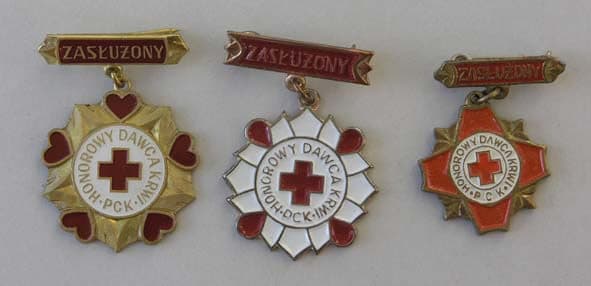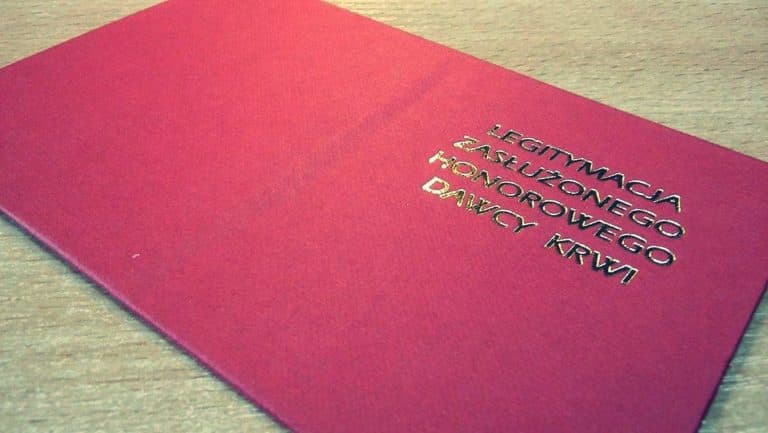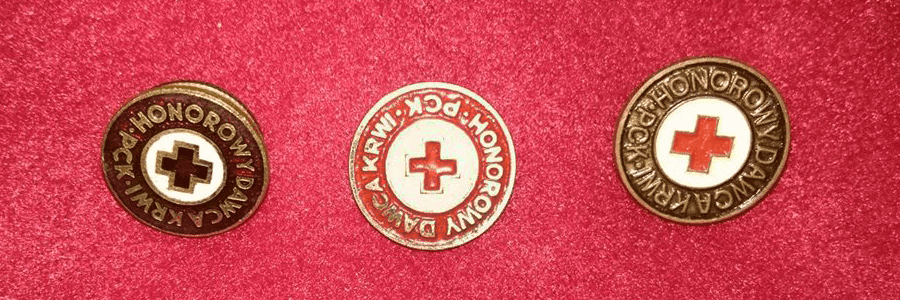On February 8, 2018, it has been 50 years since the establishment of the Honorary Blood Donor badge.

History of the Honorary Blood Donor Badge
In order to express recognition to honorary blood donors for their selflessness and noble attitude, the Polish Red Cross began introducing a series of badges in the post-war period. On February 28, 1968, the then Minister of Internal Affairs issued a decision that approved the design of the "Honored Blood Donor" badge along with permission for its use. From the beginning, the main symbol of the badge was a red cross, and the badges were issued by our organization. Over the course of these 50 years, the regulations based on which the badge is issued, along with the certificate, have changed, however, today, the appearance of the badges has not changed much from those originally issued. Initially, the production of the ZHDK badges was handled by the State Mint in Warsaw.

From the beginning, the badges have been issued by the Polish Red Cross, as we read on the certificate: "In recognition of the most beautiful humanitarian gift - selfless donation of blood" and this has not changed over the years.
Each regional branch of the PCK issues several thousand of these badges annually. Over the course of 50 years, hundreds of thousands, or maybe even millions, of blood donors have been honored with a badge featuring a red cross in the center. Only in the years 2006-2016, approximately 200,000 were issued. All certificates, despite changes, retain their validity, including the oldest ones.

Today the badge is awarded:
To blood donors:
1) to a woman who has donated at least 5 liters of blood or the equivalent amount of its components in any given period,
2) to a man who has donated at least 6 liters of blood or the equivalent amount of its components in any given period
– is entitled to the title "Honored Honorary Blood Donor of the III degree" and the bronze honorary badge "Honored Honorary Blood Donor of the III degree".
To blood donors:
1) to a woman who has donated at least 10 liters of blood or the equivalent amount of its components in any given period,
2) to a man who has donated at least 12 liters of blood or the equivalent amount of its components in any given period
– is entitled to the title "Honored Honorary Blood Donor of the II degree" and the silver honorary badge "Honored Honorary Blood Donor of the II degree".
To blood donors:
1) to a woman who has donated at least 15 liters of blood or the equivalent amount of its components in any given period,
2) to a man who has donated at least 18 liters of blood or the equivalent amount of its components in any given period
– is entitled to the title "Honored Honorary Blood Donor of the I degree" and the gold honorary badge "Honored Honorary Blood Donor of the I degree".
Earlier, in 1963, the badges of the "Honorary Blood Donor" were introduced. The design of the badges and the permission for use were covered by the decision of the Minister of Internal Affairs (no. D.22/S/X/63) from March 11, 1963, which is 55 years ago. Unfortunately, these badges have not been issued since 2001.

Facts about the Polish Red Cross
Only after the fourth request to the International Red Cross was the Polish Red Cross recognized on the international stage.
The beginnings of blood donation in the Red Cross date back to 1935, which took place 83 years ago.
If the borders of Poland had not been changed after World War II, the 100th anniversary of the Polish Red Cross (PCK) would have been celebrated with the Lviv, Volhynian, and Wilno branches, which are still active today but under the structures of different state associations.
The employees of the Polish Red Cross carried out the exhumation of Polish officers murdered in the Katyn Forest while also being responsible for creating the official Katyn Lists
The Red Cross movement and its foundations were the source for the establishment of sanitary services for wounded soldiers under the names Polish White Cross and Polish Green Cross.
Over the years, the rules for statutory financing of the PCK's activities have changed, as has our role and position within the state.
The PCK enjoyed immense public trust during the Second Polish Republic, and the most important figures in the state always spoke about our organization with the utmost respect.
To this day, in Tarnów, Małopolska, there is a nearly 100-year tradition of parades through the city organized on the occasion of the Polish Red Cross Week.
On February 8, 2018, it was 50 years since the establishment of the badge of the Honorable Blood Donor
On February 8, 2018, it marked 50 years since the establishment of the badge of the Meritorious Honorary Blood Donor
PCK never accepted any gratifications and did not support the Nazi authorities, thereby exposing itself to severe consequences.
The Polish Red Cross was the initiator of healthcare in rural areas during the interwar period and the establishment of the first village health centers.
PCK was involved in the construction of the Marshal Piłsudski Mound in Sowińca in Krakow in 1936
At the beginning of 1919, within the structures of the newly established Polish Red Cross Society, 3 District Branches of the PTCK were created: for Galicia, the Grand Duchy of Posen, and Silesia.
During its 100-year activity, the Polish Red Cross, the International Committee of the Red Cross, honored 102 Polish nurses associated with our organization with the Florence Nightingale Medal.
The Polish Red Cross was the organizer of parachuting courses
Did two Polish doctors working at the Red Cross hospital during World War II save more lives than Oskar Schindler?
There existed simultaneously the Polish Red Cross and the Polish White Cross, whose president was Helena Paderewska.
There was a time in the history of PCK when, legally, two or even three Main Boards of PCK operated simultaneously.
Help us endlessly
Thanks to the kindness and support of our Donors, we can help children, seniors, support medical rescuers, promote the idea of blood donation, and implement many other projects that save lives in times of conflict or humanitarian crises. Every donation and every form of support is significant because the Polish Red Cross connects those in need with those who want to provide help. Let’s help together!
See also
The beginnings of blood donation in the Red Cross date back to 1935, which was 83 years ago.
In 1935, the Polish Red Cross began organized activities for blood transfusion, including the organization of courses for doctors and the promotion of blood donation. The first Blood Transfusion Institute in Poland was also established.
The Red Cross Week in Polish lands was already celebrated before the Polish Red Cross was officially established, which was over 100 years ago.
Available historical sources show that the PCK Week was already celebrated by the Galician Red Cross Society led by Father Paweł Sapieha. The tradition was borrowed from the celebrations of the Austrian Red Cross.
You are currently viewing a page filtered by content from the department. Cała PolskaIf you want to view content from Cała Polskaclick the button